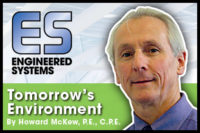Since 1985, I have being involved with nothing but engineer-led initiatives, and for me, it is far more rewarding (as well as fun) than all those earlier years as a consulting engineer chasing the more traditional projects led by other companies. So how does an engineer “change” to leader? Let’s start with positive attitude.
WHY NOT?
Back in the 1960’s Robert F. Kennedy said, “There are those who look at things the way they are, and ask why ... I dream of things that never were, and ask why not?” I have never forgotten that quote and apply it to how I approach an engineering assignment or owner representative assignment.While “asking why not” applies to creativity, it is also an important ingredient for a positive attitude, too. I know very few engineers who have the positive attitude to change their role. Part of it may be because they are comfortable doing what they do. When I left the design engineering consultant community in 1985 to move over to a design-build and O&M firm, I did it because I believed there had to be more to engineering than simply cranking out drawings and specifications. I also had the positive attitude that I could learn these parts of the building industry just like I learned how to design HVAC systems. Nine years later, I moved up the educational ladder to be a part of a construction management and facility support services firm. You need to realize there really is no holding an engineer back who is committed to persevere with that positive attitude to succeed and is commitment to “why not?”
If you are one of those who have read my book, Managing People in the HVAC/R Industry, you know I started out to be an artist and not an engineer (story for another day), so I believe I had a lead over those starting out to be engineers. But, that isn’t to say engineers can be creative. They just have to have the positive attitude to work at being creative in sync with learning and applying new HVAC equipment and concepts.
Creativity also starts with asking, “Why not?” Here is where HVAC engineers could be really good at challenging the status quo of design engineering by maybe learning and embracing design-build or integrated project delivery of engineer-driven projects (e.g., central chiller plants). With projects begging to be environmentally correct, energy-efficient, sustainable, and inexpensive to install and operate, an experienced engineer’s brain should be spinning with creative ideas to overcome these five challenges. I know from my point of view, I find each decade introduces a few new surprises/challenges to the standard project deliverables to overcome.
High energy doesn’t mean drinking a lot of those extra-caffeine-laced drinks. High energy is getting up early and being excited about the challenges ahead of you for the day. For me, that means fulfilling my “day job” (refer back to February’s “Tomorrow’s Environment” column) while in pursuit of work I want to be doing in the months and years ahead. On my own time, I write two monthly columns for this magazine, maintain my Building Smart Software venture, contribute to ASHRAE at a national level, throw in a few seminars, and then go outside to take care of my farm (I’m in charge of buildings and grounds).
Over the years, I’ve managed to also take in my children’s activities (and now my grandchildren’s activities). I believe all this qualifies me as a high-energy candidate. If engineers could expand their daily routine from just fulfilling their day job and some business development and technical committee responsibilities to include studying and being knowledgeable of new technology, outside-the-box thinking up of new building system concepts, learning the next job on the ladder of knowledge, and writing and lecturing about what the building industry should be doing in five years, then these individuals would also qualify to receive their “high-energy leadership” badge.
Committed engineers can do it if they first become proficient in time management and goal-setting while listening to self-help audios on their iPods when traveling to and from work. For those engineers striving to be positive, creative, and full of energy, prioritize what is important and then, as the Nike phrase goes, “Just do it.” They need to also embrace the quote, “There are those who look at things the way they are, and ask why ... I dream of things that never were, and ask why not?”ES


